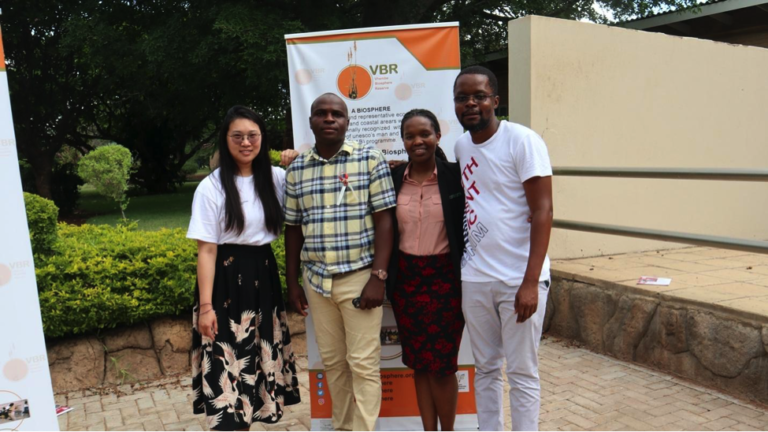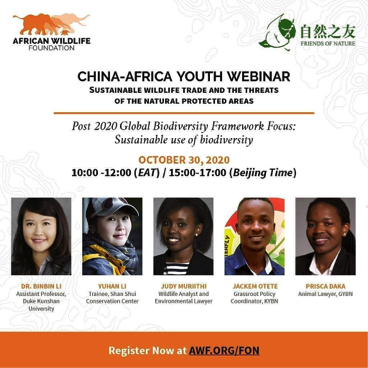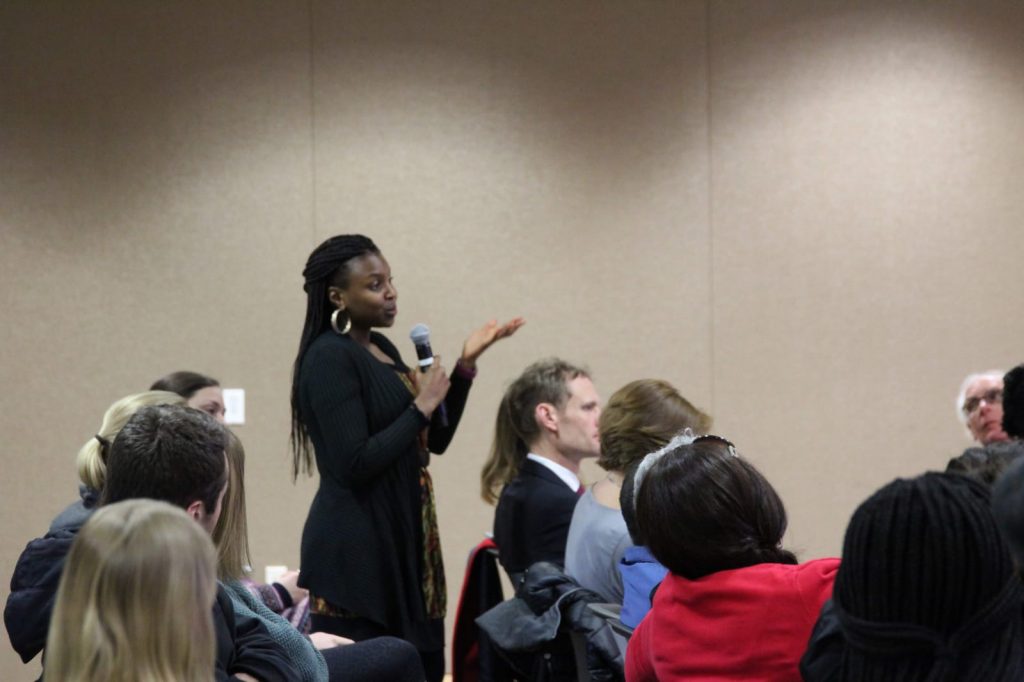Zimbabwe’s Biodiversity Advocates

Rebecca Ellison, Director, Youth, Gender and Vulnerability Policy Lab, USA
rwellison@africacfsp.org
Zimbabwean youth are reshaping environmental advocacy. As leaders of a grassroots movement, their message that biodiversity loss represents an existential crisis facing their generation is resonating with thousands of young people in Zimbabwe. The intersection of environmental and economic risk factors impacting the country is resulting in mounting pressures on the landscape, diminishing the ecological health of biodiverse as well as agricultural areas.
Zimbabwe’s Biodiversity Advocates
In 2019 the government of Zimbabwe published its Sixth National Report to the Convention on Biological Diversity (CBD), a 177-page study underscoring its concerns and accountability for protecting biodiversity within Zimbabwe. The report cites threats from climate change, economic sanctions, deforestation, invasive species, poaching, encroachment by settlers, and habitat loss for wildlife and flora endemic in Zimbabwe as primary contributors to biodiversity loss.
The government recognizes the critical role of communication and awareness-raising as important instruments to help achieve its biodiversity protection targets. It is also mindful of the growing capacity among youthful networks to successfully drive change. This change not only impacts the health of biodiversity, it also collaborates with communities to become more proactive in conservation while benefiting from alternative incomes through local tourism in rural areas.
Recognized for its Significant Ecological Reserves
Zimbabwe is known for magnificent national landmarks including Mount Nyangani, Victoria Falls as well as Hwange National Park. Its ecosystem is primarily savannah and is home to 350 mammal species, 500 birds, and 131 fish species. It also supports the second largest population of elephants on the continent as well as populations of buffalo, leopards, lions, rhinoceros, Grevy’s zebra, plains zebra, wild dogs, and giraffe.
It is also recognized for its unique biosphere reserve such as the Zambezi Valley, which has a surface area of 2,879,300 hectares, established by UNESCO in 2010. Biosphere reserves are characterized as spaces that extend beyond traditional conservation zones and are integrated with sustainable development managed by communities living on the periphery of the conservation zones. They are also regulated by participative governance structures that ensure the integrity of the ecosystems and the land-use rights of the dwellers.
Once regarded as Africa’s agricultural breadbasket, however, Zimbabwe has been severely impacted by recurring droughts and deforestation due to the fuel demands of an expanding population, resulting in an increase in poverty due to protracted economic and financial challenges. The loss of forestland is estimated to be at 330,000 hectares per year according to the Forestry Commission of Zimbabwe. Deforestation has resulted in soil damage, diminished agricultural yields, and shrinking wildlife habitats causing people to turn to poaching to supplement their income.
The Launch of the Zimbabwe Youth Biodiversity Network (ZYBN)
Across the globe, networks of young people are challenging key drivers of anthropogenic change responsible for destroying natural resources within their countries. Through the creation of the Global Youth Biodiversity Network (GYBN), recognized and supported by the Convention on Biological Diversity Secretariat, youth organizations are leading awareness campaigns on the importance of biodiversity. This not only is strengthening capacity through partnerships with governments, as well as local, national, and multinational like-minded organizations, but also serves as key representatives on negotiations with the United Nations Convention on Biological Diversity (CBD). The GYBN boasts a membership of 280 organizations representing 664,000 members from 140 countries. In 2017, the Zimbabwe Youth Biodiversity Network (ZYBN) was officially established as one of GYBN’s newest chapters.
Prisca Daka, a young 29-year-old Zimbabwean conservationist, Animal Lawyer, and environmental law LLM student, attended the first GYBN Africa Capacity Building Workshop held in Johannesburg, South Africa in August 2017. This inspired her to share her vision with other like-minded youth upon her return home to Harare, Zimbabwe. Prisca and her colleagues used social media for the next several months to gauge receptivity among young people to learn about ecological concepts and how to network with others to protect the environment.
Within 12 months the new team registered a non-profit organization and successfully launched the Zimbabwe Youth Biodiversity Network (ZYBN), the first youth-led organization in Zimbabwe that focused on biodiversity while leveraging youth networks to instill change on a national level. Through this effort they joined seven other African-led chapters of the GYBN which include networks from South Africa, Morocco, the Democratic Republic of Congo (DRC), Nigeria, Malagasy, Kenya, Uganda, Namibia, and Ghana. Their aim was to establish coalitions among school ecology clubs or through networks of young people using social media that empowers and mobilizes youth through education campaigns, workshops to strengthen advocacy skills informing policies, and capacity-building aimed at conserving biodiversity on local, national and international arenas. In just over a year their social media following has expanded to 4,400 people and continues to grow on a weekly basis.
In an interview with the Africa Center for Strategic Progress, Prisca Daka and Knowledge Vingi, a co-Founder of the ZYBN, discussed how their work advances the understanding of biodiversity-related issues on local, national, and international levels:
Rebecca: So, tell me about your members.
Prisca: For the youth that we work with, their ages range between 18 and 35. We do also work with younger kids in high school and even primary school as we also want to raise awareness about biodiversity issues with them. Our first engagement involved doing our “Web of Life” workshop to talk about biodiversity because it’s the easiest way for them to understand the concept of biodiversity and how everything is connected. We work with schools throughout the country.

Rebecca: How do you reach those who don’t have access to the internet?
Prisca: Access to the internet is definitely a big issue and, unfortunately with COVID-19, we have had to do most of our work online. So, before COVID-19 we did in-person meetings. Outside of Harare we responded to issues of human-wildlife conflict, for example, and then linked it to biodiversity discussions and how young people can become involved. It’s not just about us coming and talking about different conventions and so on. Whatever issue they are focusing on we try to link it back to problem solving through understanding biodiversity. We are also organizing capacity building workshops for rural youth communities, and we will literally work with anyone and go anywhere to share our knowledge.
The good thing about this work is that it’s open for everyone to participate in how we are going to achieve the 2050 vision of living in harmony with nature. It’s going to be important for everyone to be involved – especially the young people, because we are going to inherit the planet. We are using this as an opportunity to help them understand that this is their right and through active involvement they are going to be acknowledged and taken into account by our leaders. They will not be ignored, and they will be able to have a seat at the table and their voices will not be gagged. It all happens when young people stand together.
Knowledge: We also try collaborations like she mentioned. We create partnerships with local youth-based organizations to access those outside Harare and with little or no access to the internet and amplify inputs from their perspective.
Rebecca: What are your partnerships like and what types of organizations do you work with in Zimbabwe?
Knowledge: We work through local youth led or focused organizations. When we are doing a program, we look for partners in the project area to address specific issues. We do most of the information sharing through social media to connect with our partners across Zimbabwe.
Of the most active members you will also find that they have a background in environmental science or ecology or climate change education. Their understanding of biodiversity is from an informed position. Some of the organizations we have worked or work with include: GreenHut, Green Governance, Trust Tibokane Trust, Mutasa Youth Forum Trust, Great Zimbabwe University Environmental Law Club, African Youth Initiative on Climate Change, Innovative Village for Young African Minds, Scouts Association of Zimbabwe, and Action 24. We work with them by trying to complement their existing mission and work as an amplifier as we have a global reach and respect as an organization.
Prisca: In addition, we also work with the African Wildlife Foundation (AWF),
World Wildlife Fund Zimbabwe and UNESCO Zimbabwe to engage the youth. We also endeavor to work with the Zimbabwe National Biodiversity Office, as they are responsible for overseeing biodiversity in Zimbabwe and other decision-making agencies. Zimbabwe has 10 different provinces with different environmental challenges with different youth groups addressing these issues already. It doesn’t make sense for us just to go there and try to establish ourselves. For us partnerships are important because there isn’t one organization which can solve the challenges which we are facing today.
For me, if we are really doing work that helps others and changing people’s lives for the better, then it’s worth it to work with others! If you think about biodiversity, like I mentioned it’s the web of life, this is where we get everything like our food, our water, our clothes, and everything that we need in life is impacted by the loss of biodiversity. The most affected groups are those living in the rural areas and depend on biodiversity for their well-being. We need healthy ecosystems. This is why we focus on biodiversity, policy, and to ensure that young people are involved in biodiversity management. You want to avoid having to say, “we used to have these types of flowers and plants, they are no longer here because they have gone extinct”. We want to be active now when we can do something about extinction before it’s too late.
Rebecca: Is there any part of your education framework that draws upon indigenous knowledge?
Prisca: Yes, we do acknowledge that indigenous knowledge is quite important the same way science is important, and we do include this aspect in our programs. Indigenous knowledge is important because when you look at indigenous communities that live near biodiverse places and nature – you find that biodiversity loss is happening at a lower rate compared to other areas. For them, they really do respect the connection humans have with nature, so they don’t see themselves as being separate compared to those living in urban areas. However, there is a lot we can learn from indigenous knowledge systems and much still needs to be done to mainstream it into our policies and development generally.
Rebecca: You have done a lot within a year of registration from being a national organization to one that participates on the global stage. The fact that I am even talking to you all right now is due to the exposure you have gained through other organizations. What has that experience been like for you?
Prisca: When you see us now you think it’s quite easy, but I can assure you that when we started a year ago, we would have never thought that we would be here. When you are a youth group people tend to take you for granted and naturally assume you don’t know anything. We tell them that we are talking about biodiversity and we don’t need ten years of experience but just the interest and passion! Being part of the GYBN, we are able to participate in global discussions but at some point, you have to come back home. Some of the solutions that you hear about on a global level are not always going to translate in Zimbabwe. When you are in Zimbabwe you have to think about how to do things locally and what resources are required to get them accomplished. These connections built through this have been rewarding and we also use such opportunities to exchange information on best practices and promote the wonderful biodiversity we have in Zimbabwe.

Rebecca: Which projects are you most proud of?
Prisca: The youth consultations we have been doing under the post-2020 Biodiversity Framework. It’s an opportunity for young people in Zimbabwe to contribute to a future they want and to the global youth position. Being able to connect these views to the CBD, heads of government, decision makers, that is quite important for us. Our voices are being heard. For us, that is one of the projects that gets us excited. It’s also being at home and building relationships with Zimbabwean policy makers and including young people. These consultations and also the Standup 4 Nature youth advocacy training that we have been doing make us proud because it’s about capacity-building and empowering young people. It’s scary trying to change policy so with this capacity building we help them gain the skills they need like, how do you talk to your minister, how do you talk to a member of parliament because you are trying to get them to see your point of view as well. We are also working on a documentary called Saving the Samango Monkey which is part of a larger project.
Knowledge: Those three projects were exciting as we had a very good time with participants and members of the community showing that they really wanted to explore policy issues and biodiversity conservation. The Samango Monkey is special and endemic to the Eastern Highlands of Zimbabwe. We hope local communities can use this as an opportunity to raise awareness and to establish local tourism as a way of educating people about these monkeys.
Rebecca: What are other challenges you have experienced?
Prisca: Lack of intergenerational equity-which is one of the elements we are advocating for under the Post-2020 Global Biodiversity Framework discussions. When you are young chances are you won’t be taken seriously, and this is something we faced when we started, but one thing that can’t be taken away from us is that we are experts at being youth hence reason we are fighting to ensure our concerns are addressed not just for us but for the benefit of future generations. This is what intergenerational equity seeks to achieve, older generations working together with the younger generations. You have to fight to get a seat at the table and when you do finally get a seat at the table you fight to be heard once you get there. When there are big things happening, the youth are not the first people think of inviting [to discussions] by older generations. We are young people who bring valuable experience and knowledge they also don’t already have. Lack of funding is also a challenge because these resources help achieve or implement projects. We do however try our best to defray as much costs as we can through partnerships or finding creative ways to engage with little to no cost at all.
Moving Towards Youth Empowerment and Biodiversity Conservation
Youth-led conservation organizations have been largely excluded from biodiversity policy and are not sought for their expertise nor invited to consultations about current nor future needs concerning the protection of biodiversity. The lack of progress in collaboration is delaying critically needed solutions to address the mounting ecological challenges facing the country today. An opportunity exists for the Zimbabwean government to leverage the experiences of this well-developed network to help guide national policies and strategies towards conserving Zimbabwe’s natural endowments, thereby ensuring its biodiversity is safely protected for the benefit and wellbeing of future generations.
Members of the ZYBN discover creative ways to bridge digital and educational divides and collaborate with other like-minded and geographically dispersed youth. Through these networks, successive cohorts of young people can effectively organize, become informed, and engage in policies that positively impact the environmental and economic prosperity of the country. As an organization with national and international recognition it can channel the concerns and aspirations of the youth through the agency of the GYBN and the parameters established by the CBD.
Based on your interests, you may also wish to read:
- Women as Peacemakers in Senegal – Voices To Be Heard
- Kenya Should Adopt Comprehensive Sexuality Education to Address the Vulnerability of Girls to Early Pregnancies
- COVID-19, Youth and Tech: The Chance to Build a Resilient Nigerian Economy?
- Burkinabe Men in Collective Action Against Gender-Based Violence


